过去分词作状语
- 格式:ppt
- 大小:488.00 KB
- 文档页数:8
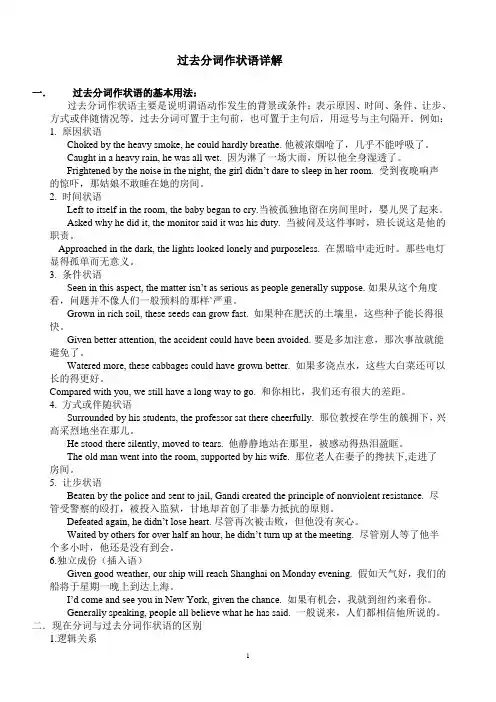
过去分词作状语详解一.过去分词作状语的基本用法:过去分词作状语主要是说明谓语动作发生的背景或条件;表示原因、时间、条件、让步、方式或伴随情况等。
过去分词可置于主句前,也可置于主句后,用逗号与主句隔开。
例如:1. 原因状语Choked by the heavy smoke, he could hardly breathe. 他被浓烟呛了,几乎不能呼吸了。
Caught in a heavy rain, he was all wet. 因为淋了一场大雨,所以他全身湿透了。
Frightened by the noise in the night, the girl didn’t dare to sleep in her room. 受到夜晚响声的惊吓,那姑娘不敢睡在她的房间。
2. 时间状语Left to itself in the room, the baby began to cry.当被孤独地留在房间里时,婴儿哭了起来。
Asked why he did it, the monitor said it was his duty. 当被问及这件事时,班长说这是他的职责。
Approached in the dark, the lights looked lonely and purposeless. 在黑暗中走近时。
那些电灯显得孤单而无意义。
3. 条件状语Seen in this aspect, the matter isn’t as serious as people generally suppose.如果从这个角度看,问题并不像人们一般预料的那样`严重。
Grown in rich soil, these seeds can grow fast. 如果种在肥沃的土壤里,这些种子能长得很快。
Given better attention, the accident could have been avoided. 要是多加注意,那次事故就能避免了。


过去分词作状语的用法归纳
1. 哎呀,当过去分词表示被动或完成的时候,就可以作状语啦!就像“He was deeply moved by the story.”这里的“moved”就是被故事深深打动呀。
2. 嘿,要是过去分词用来表达原因,那也是很妙的哟!比如说“Frustrated by the failure, he almost gave up.”这“Frustrated”不就是因为失败而沮丧嘛。
3. 哇塞,当过去分词表示时间,这多神奇呀!像“Seen from the top of the mountain, the view is amazing.”看到没,“Seen”就是从山顶被看到那个时间点呀。
4. 哟呵,过去分词表示条件的时候,是不是很有意思呀!例如“If prepared well, you will do great.”这里的“prepared”就是如果准备好这个条件呀。
5. 哈哈,过去分词还能表示让步呢!像“Though beaten many times, he still doesn't give up.”“beaten”就是尽管被打击很多次啦。
6. 哎呀呀,当表示方式或伴随的时候,过去分词也能上呀!比如“She sat there, lost in thought.”“lost”不就是那种伴随的状态嘛。
7. 嘿呀嘿呀,过去分词作状语的时候,可真是变化多端呢!就像“Surrounded by his friends, he feels happy.”“Surrounded”就是周围被朋友围着呀。
8. 哇哦,过去分词这么有用,大家可得好好掌握呀!
总之,过去分词作状语的用法很多,大家要多多练习,才能运用自如呀!。
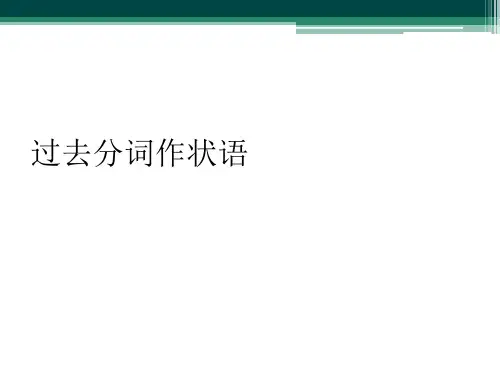
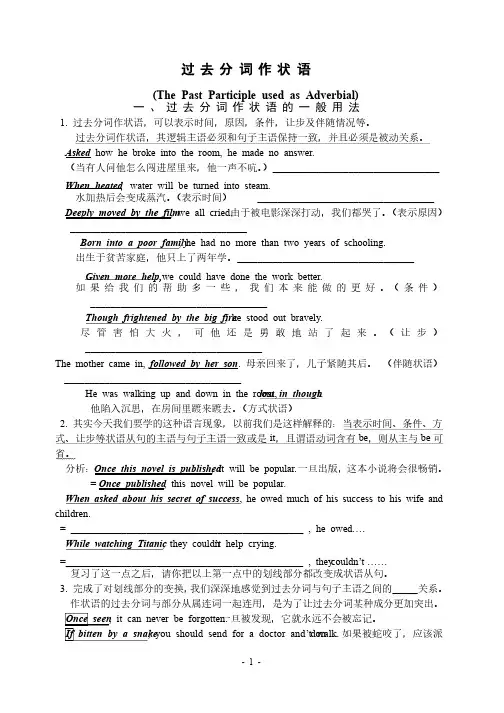
过去分词作状语(The Past Participle used as Adverbial) 一、过去分词作状语的一般用法1. 过去分词作状语,可以表示时间,原因,条件,让步及伴随情况等。
过去分词作状语,可以表示时间,原因,条件,让步及伴随情况等。
过去分词作状语,其逻辑主语必须和句子主语保持一致,并且必须是被动关系。
过去分词作状语,其逻辑主语必须和句子主语保持一致,并且必须是被动关系。
Asked how he broke into the room, he made no answer. (当有人问他怎么闯进屋里来,他一声不吭。
)_________________________________ When heated ,water will be turned into steam. 水加热后会变成蒸汽。
(表示时间)(表示时间) ___________________________________ Deeply moved by the film , we all cried. 由于被电影深深打动,我们都哭了。
(表示原因)___________________________________ Born into a poor family , he had no more than two years of schooling. 出生于贫苦家庭,他只上了两年学。
___________________________________ Given more help, we could have done the work better. 如果给我们的帮助多一些,我们本来能做的更好。
(条件)___________________________________ Though frightened by the big fire , he stood out bravely. 尽管害怕大火,可他还是勇敢地站了起来。
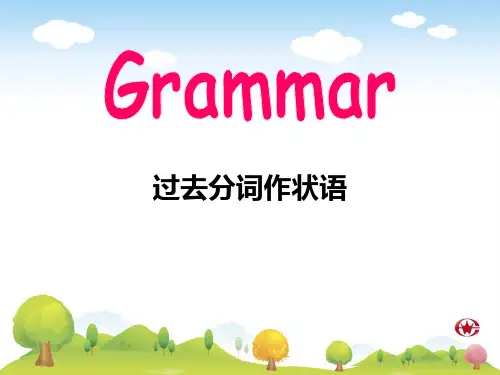
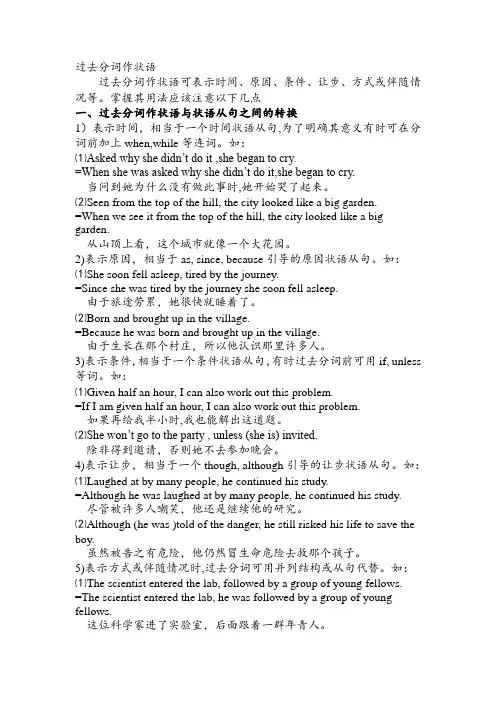
过去分词作状语过去分词作状语可表示时间、原因、条件、让步、方式或伴随情况等。
掌握其用法应该注意以下几点一、过去分词作状语与状语从句之间的转换1)表示时间,相当于一个时间状语从句,为了明确其意义有时可在分词前加上when,while等连词。
如:⑴Asked why she didn’t do it ,she began to cry.=When she was asked why she didn’t do it,she began to cry.当问到她为什么没有做此事时,她开始哭了起来。
⑵Seen from the top of the hill, the city looked like a big garden.=When we see it from the top of the hill, the city looked like a big garden.从山顶上看,这个城市就像一个大花园。
2)表示原因,相当于as, since, because引导的原因状语从句。
如:⑴She soon fell asleep, tired by the journey.=Since she was tired by the journey she soon fell asleep.由于旅途劳累,她很快就睡着了。
⑵Born and brought up in the village.=Because he was born and brought up in the village.由于生长在那个村庄,所以他认识那里许多人。
3)表示条件,相当于一个条件状语从句,有时过去分词前可用if, unless 等词。
如:⑴Given half an hour, I can also work out this problem.=If I am given half an hour, I can also work out this problem.如果再给我半小时,我也能解出这道题。
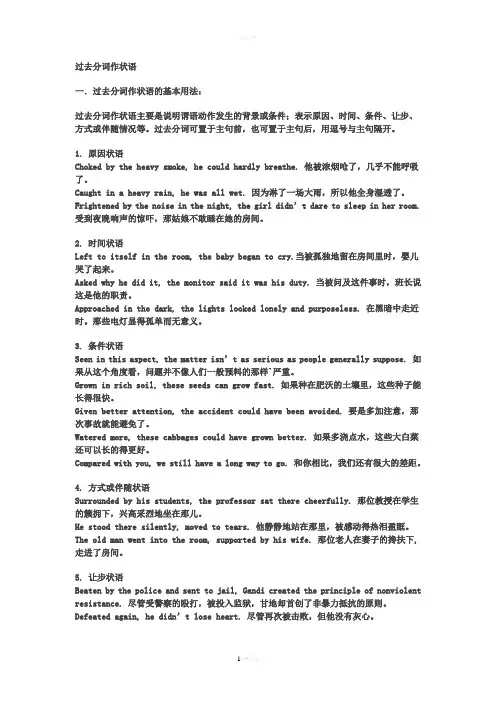
过去分词作状语一.过去分词作状语的基本用法:过去分词作状语主要是说明谓语动作发生的背景或条件;表示原因、时间、条件、让步、方式或伴随情况等。
过去分词可置于主句前,也可置于主句后,用逗号与主句隔开。
1. 原因状语Choked by the heavy smoke, he could hardly breathe. 他被浓烟呛了,几乎不能呼吸了。
Caught in a heavy rain, he was all wet. 因为淋了一场大雨,所以他全身湿透了。
Frightened by the noise in the night, the girl didn’t dare to sleep in her room. 受到夜晚响声的惊吓,那姑娘不敢睡在她的房间。
2. 时间状语Left to itself in the room, the baby began to cry.当被孤独地留在房间里时,婴儿哭了起来。
Asked why he did it, the monitor said it was his duty. 当被问及这件事时,班长说这是他的职责。
Approached in the dark, the lights looked lonely and purposeless. 在黑暗中走近时。
那些电灯显得孤单而无意义。
3. 条件状语Seen in this aspect, the matter isn’t as serious as people generally suppose. 如果从这个角度看,问题并不像人们一般预料的那样`严重。
Grown in rich soil, these seeds can grow fast. 如果种在肥沃的土壤里,这些种子能长得很快。
Given better attention, the accident could have been avoided. 要是多加注意,那次事故就能避免了。
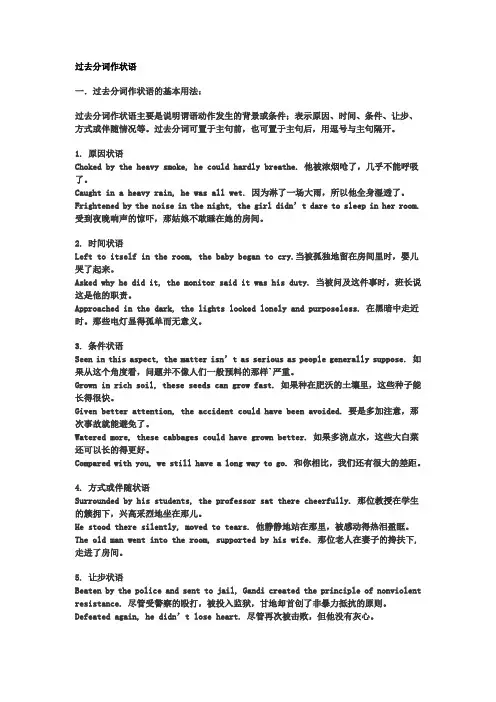
过去分词作状语一.过去分词作状语的基本用法:过去分词作状语主要是说明谓语动作发生的背景或条件;表示原因、时间、条件、让步、方式或伴随情况等。
过去分词可置于主句前,也可置于主句后,用逗号与主句隔开。
1. 原因状语Choked by the heavy smoke, he could hardly breathe. 他被浓烟呛了,几乎不能呼吸了。
Caught in a heavy rain, he was all wet. 因为淋了一场大雨,所以他全身湿透了。
Frightened by the n oise in the night, the girl didn’t dare to sleep in her room. 受到夜晚响声的惊吓,那姑娘不敢睡在她的房间。
2. 时间状语Left to itself in the room, the baby began to cry.当被孤独地留在房间里时,婴儿哭了起来。
Asked why he did it, the monitor said it was his duty. 当被问及这件事时,班长说这是他的职责。
Approached in the dark, the lights looked lonely and purposeless. 在黑暗中走近时。
那些电灯显得孤单而无意义。
3. 条件状语Seen in this aspect, the matter isn’t as serious as people generally suppose. 如果从这个角度看,问题并不像人们一般预料的那样`严重。
Grown in rich soil, these seeds can grow fast. 如果种在肥沃的土壤里,这些种子能长得很快。
Given better attention, the accident could have been avoided. 要是多加注意,那次事故就能避免了。
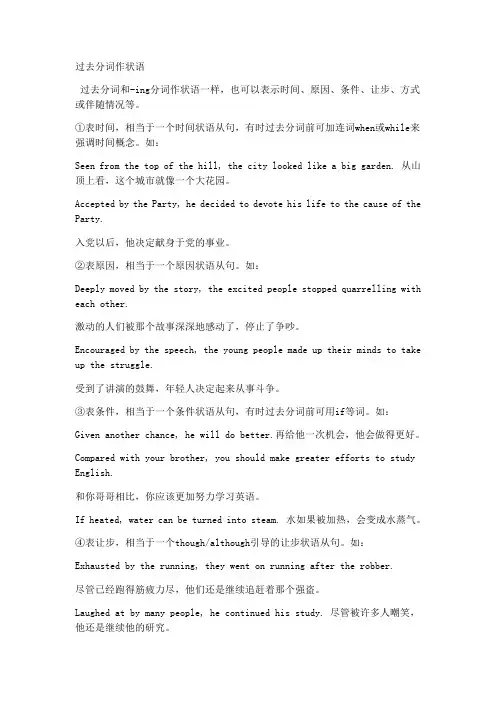
过去分词作状语过去分词和-ing分词作状语一样,也可以表示时间、原因、条件、让步、方式或伴随情况等。
①表时间,相当于一个时间状语从句,有时过去分词前可加连词when或while来强调时间概念。
如:Seen from the top of the hill, the city looked like a big garden. 从山顶上看,这个城市就像一个大花园。
Accepted by the Party, he decided to devote his life to the cause of the Party.入党以后,他决定献身于党的事业。
②表原因,相当于一个原因状语从句。
如:Deeply moved by the story, the excited people stopped quarrelling with each other.激动的人们被那个故事深深地感动了,停止了争吵。
Encouraged by the speech, the young people made up their minds to take up the struggle.受到了讲演的鼓舞,年轻人决定起来从事斗争。
③表条件,相当于一个条件状语从句,有时过去分词前可用if等词。
如:Given another chance, he will do better.再给他一次机会,他会做得更好。
Compared with your brother, you should make greater efforts to study English.和你哥哥相比,你应该更加努力学习英语。
If heated, water can be turned into steam. 水如果被加热,会变成水蒸气。
④表让步,相当于一个though/although引导的让步状语从句。
如:Exhausted by the running, they went on running after the robber.尽管已经跑得筋疲力尽,他们还是继续追赶着那个强盗。
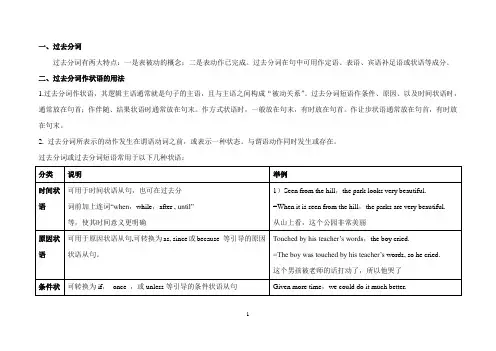
一、过去分词
过去分词有两大特点:一是表被动的概念;二是表动作已完成。
过去分词在句中可用作定语、表语、宾语补足语或状语等成分。
二、过去分词作状语的用法
1.过去分词作状语,其逻辑主语通常就是句子的主语,且与主语之间构成“被动关系”。
过去分词短语作条件、原因、以及时间状语时,通常放在句首;作伴随、结果状语时通常放在句末。
作方式状语时,一般放在句末,有时放在句首。
作让步状语通常放在句首,有时放在句末。
2. 过去分词所表示的动作发生在谓语动词之前,或表示一种状态。
与谓语动作同时发生或存在。
过去分词或过去分词短语常用于以下几种状语:
1
2。
过去分词作状语举例过去分词可以用作状语,修饰主句中的动词或整个句子。
以下是几个例子:1. Exhausted from the long hike, he collapsed onto the ground.(他疲惫不堪地倒在地上,因为长时间的徒步旅行)2. Driven by passion, she pursued her dreams relentlessly.(受到激情的驱使,她不懈追求梦想)3. Having finished her work, she went out for a walk.(她完成了工作,出去散步了)4. Scared by the loud noise, the cat ran away.(受到巨响的惊吓,猫跑了)5. Broken by the news, she burst into tears.(受到消息的打击,她放声大哭)6. Surprised by the sudden appearance of her friend, she hugged her tightly.(因为朋友突然出现,她感到惊喜,紧紧拥抱她)7. Lost in thought, he didn't notice the time passing.(沉思中,他没有注意到时间的流逝)8. Having been told the truth, he finally understood the situation.(听了真相后,他终于理解了情况)9. Confused by the directions, he asked for help.(因为方向不清,他请求帮助)10. Entertained by the movie, the audience applauded loudly.(因为电影很有趣,观众热烈鼓掌)1/ 1。
什么时候过去分词作状语
过去分词作状语是中文中的一种语法现象,它在句子中充当状语,用来表示主语动作的时间、原因、条件、方式、结果等,起到修饰动
词的作用。
它可以单独出现在句子中,也可以和连词“当…时,一…就…”连用。
在句子中,过去分词作状语时,通常表示的是已经发生的动作或
状态。
它可以表示时间的先后顺序、因果关系、条件关系、目的等。
当过去分词作时间状语时,可以表示的时间可以是过去、现在甚至是
将来。
在句子中,过去分词作状语可以使用不限于“看到、听到、了
解到、了解到、了解到、了解到、了解到、了解到、了解到、了解到、了解到发现、要求…等”
比如:
1.我走过去一看,他已经离开了。
2.我听说他进了医院,我立刻赶了过去。
3.他做完作业就去打篮球了。
4.太阳落山的时候,他还在工作。
过去分词作状语的句子有时候也可以通过改变主语的位置,将过
去分词置于主语之后,这样可以加强句子的逻辑关系,使句子更通顺。
这种句型通常通过“由于、因为、尽管、虽然、当…时,一…就…”
等连词连接。
比如:
1.由于工作繁忙,他常常加班到很晚。
2.因为生病了,他没能参加聚会。
3.虽然下雨了,但他照样去了操场。
总之,过去分词作状语是中文语法中的一种重要现象,它通过修
饰动词,增强了句子的信息量,使句子更加丰富和生动。
在写作中,
我们可以通过增加过去分词作状语的句式结构,使句子更加多样化,
达到丰富语言表达的目的。
过去分词作状语
过去分词作状语的情况分类如下:
1、过去分词做时间状语。
Asked about his family,he made no answer。
当问到有关他的家庭的情况时,他没有回答。
2、过去分词做条件状语。
United,we stand,divided,we fall。
团结,我们就能独立;分裂,我们必然倒下。
3、过去分词做方式或伴随状语。
The boy slipped out of the room,followed by his pet dog。
这个男孩溜出了房间,后面跟着他的宠物狗。
4、过去分词做让步状语。
Rejected many times,the man did not lose heart。
虽然被拒绝了很多次,这个人并没有失去信心。
5、过去分词作原因状语。
Seriously injured,he had to be taken to the hospital。
由于伤得很严重,只好把他送往医院。
过去分词(短语)作状语吴国斌过去分词(短语)作状语,它的逻辑主语通常就是句子的主语,过去分词与主语之间是动宾关系,即被动关系。
过去分词(短语)作状语可以表时间、原因、条件、让步、方式或伴随情况等。
1.时间状语过去分词作时间状语,相当于一个时间状语从句。
也可在过去分词前加上连词when,while,until等,使其时间意义更明确。
Seen from the top of the hill, the city looks more beautiful=When it is seen from the top of the hill, the city looks more beautiful.从山顶看,城市显得更漂亮。
Don’t speak until asked to.=Don’t speak until you are asked to.当被要求发言时,你才能讲话。
2.原因状语过去分词作原因状语,相当于一个原因状语从句。
Encouraged by the progress he has made, he works harder.=As he is encouraged by the progress he has made, he works harder.由于受到所取得的进步的鼓励,他工作更努力了。
3.条件状语作条件状语的过去分词(短语)可转换为if,unless等引导的条件状语从句。
United we will stand; divided we will fall.=If we are united we will stand; if we are divided we will fall.团结写就是胜利,分裂必然失败。
4.让步状语作让步状语的过去分词(短语)可转换为although,though或even if/though 等引导的让步状语从句。
Though warned of the storm, the farmers were still working in the fields.=Though they had been warned of the storm, the farmers were still working in the fields.虽然农民们已被警告将有风暴,但他们仍然在地里干活。
过去分词作状语的例句英语一.过去分词(短语)作状语表示动作发生的背景或情况,在意义上相当于一个状语从句,其逻辑主语就是句子的主语。
过去分词(短语)在句中作状语可以表示时间、条件、方式或伴随、让步、原因等。
1.表示时间:过去分词(短语)做时间状语,相当于一个时间从句。
例如:Asked about his family, he made no answer=When he was asked about his family, he made no answer.当问到有关他的家庭的情况时,他没有回答。
2.表示条件:过去分词(短语)做条件状语,相当于一个条件状语从句。
这类句子的谓语动词往往用将来时或情态动词。
例如:United, we stand;divided,we fall=If we are united,we stand;if we are divided, we fall.团结,我们就能独立;分裂,我们必然倒下。
3.表示方式或伴随:过去分词(短语)做方式或伴随状语,可以转换成一个并列句。
例如:The boy slipped out of the room, followed by his pet dog=The boy slipped out of the room and was followed by his pet dog.这个男孩溜出了房间,后面跟着他的宠物狗。
4.表示让步:过去分词(短语)做让步状语,相当于一个让步状语从句。
例如:Rejected many times, the man did not lose heart=Though the man was rejected many times, he did not lose heart.虽然被拒绝了很多次,这个人并没有失去信心。
5.表示原因:过去分词(短语)作原因状语,相当于一个原因状语从句。
例如:Seriously injured, he had to be taken to the hospital=Because he was seriously injured, he had to be taken to the hospital.由于伤得很严重,只好把他送往医院。